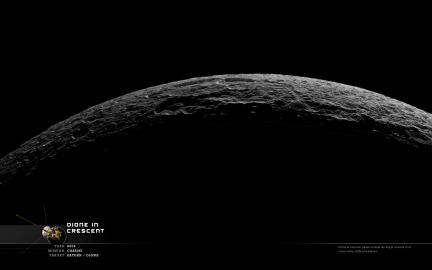 An almost Apollo class image of the cliffs of Dione rising at its horizon. Many of the cliffs pictured here are from impact craters, but Dione is also well known for its “wispy” details which have been revealed by Cassini as fractures which result in giant ice cliffs and valleys. You can see one crater actually cross-sectioned by one of these fractures at the extreme far right side of the wallpaper image above.
An almost Apollo class image of the cliffs of Dione rising at its horizon. Many of the cliffs pictured here are from impact craters, but Dione is also well known for its “wispy” details which have been revealed by Cassini as fractures which result in giant ice cliffs and valleys. You can see one crater actually cross-sectioned by one of these fractures at the extreme far right side of the wallpaper image above.
The origins of these fractures are yet unknown and it is generally accepted that these are relatively recent formations as many of them run through impact craters which are known all over the solar system to be ancient details. As a matter of fact, impact cratering is how most planetary scientists are able to rate the age of a surface by the absence or presence of crater events. Bodies with many craters (our moon, Callisto and Mercury) are considered to be old and generally unchanged since early in its formation history as it is assumed that the period of heavy cratering happened soon after the formation of the solar system. Bodies with less cratering (like Earth, Io and Titan) are considered to have “young” surfaces which have been geologically changed over the ages and erased the record of impact cratering.